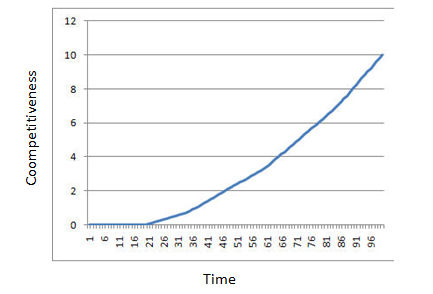Launching and growing new sites from scratch can seem more like torture than pleasure. One thing that can make the start even more painful is waiting for the conversions to start coming.
Interestingly, the conversions don’t seem to grow along the same curve as the traffic, they grow more slowly. Why is this the case? Let’s explore.
Short answer: because the initial traffic you get for your site will be on non-competitive keywords. The reason that they are non-competitive is that they are non-converting.
Note: this article doesn’t apply to sites that start with a huge and successful PR campaign, or that take off early by going viral. It applies to sites that go through a more organic growth pattern.
Here’s a chart of what the traffic growth for the website might look like:

The time intervals on the x-axis don’t really matter (days, weeks, months…) as this is all relative for purposes of this discussion. The site shows steady growth over time. It isn’t unusual for sites to plateau (show flat growth) for periods of time, but that’s another discussion.
Based on this traffic growth, and a conversion rate of 1 percent, you might think you would get conversion growth like this:

The 1 percent figure is just for simplicity, and the target conversion rate for your industry may be quite different. B2B sites usually convert at lower rates than B2C sites, for example.
For our example scenario, we’re using 1 percent as a measure of our progress. We may be hoping to get to 1.5 percent once we’re rolling, but once we get in the 1 percent region we know we’re beginning to hit our stride.
We’ll also ignore the impact of conversion rate optimization and the impact it would have on the data, and assume that no conversion optimization work is in play here. For the record, conversion rate optimization is important and you should be doing it, as it can have a big impact on your business. But we’re only focusing on the SEO related factors at work now.
With that said, here is a chart that shows what the actual growth might look like against with the 1 percent baseline shown in red:

Since the baseline is 1 percent of traffic growth we can see how the conversion growth lags significantly behind traffic growth. In fact, in the early days we get basically no conversions at all. Very frustrating! So what is going on here?
It comes down to competitiveness. Search engine algorithms are always comparing your site to those of other sites that are relevant for the same terms.
A new site has lots of disadvantages in this competition. For example, it’s new and untrusted, and it has a weak link profile, no social media history, and no user engagement history. Sites that have been around for awhile have advantages in all of these areas.
The result is that the first traffic a brand new site gets is for non-competitive keywords. The keywords are non-competitive because they don’t convert well. They haven’t attracted the attention of the pre-existing competition, so they aren’t trying to rank for them.
Here’s a chart of what the competitiveness of the keywords they are able to rank for might look like over the same time period in which we saw the traffic growth:

The new site simply has to struggle through this phase to get to the point where they start to compete for converting keywords.
Summary
This traffic pattern isn’t uncommon for new sites launched without the benefit of a large PR effort, going viral, or a strong pre-existing brand behind them. For these types of sites, a slower slog through the process of growing traffic can be expected.
Be patient with the conversions if they don’t come right away, because it’s reasonable to expect that the first traffic you get will be from lower converting keywords.
Of course, there are sites that will never convert because there is a poor match between the commercial model and the content used to attract traffic, and that is a separate issue. But, if you’re convinced that you have the right content to attract converting traffic, you may just need to wait until you get the traffic up to a certain level before you begin to see reasonable conversion rates.



